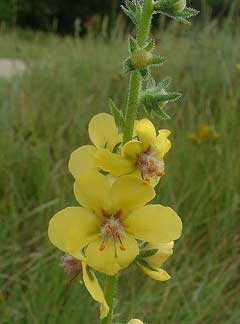 |
|
commons.wikimedia.org/wiki/User:Sphl |
 |
| commons.wikimedia.org/wiki/File:Verbascum_blattaria2.jpg |
Translate this page:
Summary
Physical Characteristics

 Verbascum blattaria is a BIENNIAL/PERENNIAL growing to 1 m (3ft 3in).
Verbascum blattaria is a BIENNIAL/PERENNIAL growing to 1 m (3ft 3in).
See above for USDA hardiness. It is hardy to UK zone 6. It is in flower from June to October, and the seeds ripen from August to October. The species is hermaphrodite (has both male and female organs) and is pollinated by Insects. The plant is self-fertile.
Suitable for: light (sandy), medium (loamy) and heavy (clay) soils and prefers well-drained soil. Suitable pH: mildly acid, neutral and basic (mildly alkaline) soils. It cannot grow in the shade. It prefers dry or moist soil.
UK Hardiness Map
US Hardiness Map
Synonyms
Plant Habitats
Cultivated Beds;
Edible Uses
References More on Edible Uses
Medicinal Uses
Plants For A Future can not take any responsibility for any adverse effects from the use of plants. Always seek advice from a professional before using a plant medicinally.
None known
References More on Medicinal Uses
The Bookshop: Edible Plant Books
Our Latest books on Perennial Plants For Food Forests and Permaculture Gardens in paperback or digital formats.

Edible Tropical Plants
Food Forest Plants for Hotter Conditions: 250+ Plants For Tropical Food Forests & Permaculture Gardens.
More

Edible Temperate Plants
Plants for Your Food Forest: 500 Plants for Temperate Food Forests & Permaculture Gardens.
More

More Books
PFAF have eight books available in paperback and digital formats. Browse the shop for more information.
Shop Now
Other Uses
Repellent
The plant repels insects, it is used indoors to repel moths and cockroaches[124]. Dynamic accumulator.
Special Uses
Dynamic accumulator
References More on Other Uses
Cultivation details
An easily grown plant, it succeeds in most well-drained soils, including dry ones, and prefers a sunny position[187, 200]. Dislikes shade[200]. Plants are hardy to about -20°c[187]. Hybridizes with other members of this genus, though the progeny are usually sterile[200].
References Carbon Farming Information and Carbon Sequestration Information
Temperature Converter
Type a value in the Celsius field to convert the value to Fahrenheit:
Fahrenheit:
The PFAF Bookshop
Plants For A Future have a number of books available in paperback and digital form. Book titles include Edible Plants, Edible Perennials, Edible Trees,Edible Shrubs, Woodland Gardening, and Temperate Food Forest Plants. Our new book is Food Forest Plants For Hotter Conditions (Tropical and Sub-Tropical).
Shop Now
Plant Propagation
Seed - sow late spring to early summer in a cold frame and only just cover the seed[200]. Germination usually takes place within 2 - 3 weeks. When they are large enough to handle, prick out the seedlings into individual pots and plant them out in late summer. The seed has a long viability[200].
Other Names
If available other names are mentioned here
Native Range
TEMPERATE ASIA: Afghanistan, Cyprus, Iran, Israel, Jordan, Lebanon, Syria, Turkey, Russian Federation-Ciscaucasia (Ciscaucasia), Armenia, Azerbaijan, Georgia, Russian Federation (Dagestan), Russian Federation-Western Siberia (Western Siberia), Kazakhstan, Tajikistan, Turkmenistan, Uzbekistan, China (Xinjiang Uygur Zizhiqu (north)) EUROPE: Austria, Belgium, Switzerland, Czech Republic, Germany, Hungary, Netherlands, Poland, Slovakia, Russian Federation (European part), Belarus, Estonia, Lithuania, Moldova, Ukraine (incl. Krym), Albania, Bulgaria, Greece, Croatia, Italy (incl. Sardinia, Sicily), Romania, Serbia, Slovenia, Spain, France (incl. Corsica) AFRICA: Algeria, Libya, Morocco, Tunisia
Weed Potential
Right plant wrong place. We are currently updating this section.
Please note that a plant may be invasive in one area but may not in your area so it's worth checking.
Conservation Status
IUCN Red List of Threatened Plants Status :

| Related Plants
|
| Latin Name | Common Name | Habit | Height | Hardiness | Growth | Soil | Shade | Moisture | Edible | Medicinal | Other |
| Verbascum densiflorum | Mullein | Biennial | 1.2 |
4-8
| | LMH | N | DM | 0 | 2 | 2 |
| Verbascum lychnitis | White Mullein | Biennial | 1.0 |
5-9
| | LMH | N | DM | 0 | 0 | 2 |
| Verbascum nigrum | Dark Mullein, Black mullein | Biennial/Perennial | 1.0 |
4-8
| | LMH | N | DM | 0 | 3 | 2 |
| Verbascum phlomoides | Wooly Mullein, Orange mullein | Biennial/Perennial | 1.2 |
5-9
| | LMH | N | DM | 0 | 3 | 2 |
| Verbascum pulverulentum | Hoary Mullein, Broad-leaf mullein | Biennial | 1.8 |
3-7
| | LMH | N | DM | 0 | 1 | 2 |
| Verbascum thapsus | Great Mullein, Common mullein, Aaron's Rod, Flannel Plant, Hag Taper, Mullein, Torches, Velvet Plant | Biennial | 1.8 |
3-8
| F | LMH | N | DM | 1 | 3 | 4 |
|
Growth: S = slow M = medium F = fast. Soil: L = light (sandy) M = medium H = heavy (clay). pH: A = acid N = neutral B = basic (alkaline). Shade: F = full shade S = semi-shade N = no shade. Moisture: D = dry M = Moist We = wet Wa = water.
Now available:
Food Forest Plants for Mediterranean Conditions
350+ Perennial Plants For Mediterranean and Drier Food Forests and Permaculture Gardens.
[Paperback and eBook]
This is the third in Plants For A Future's series of plant guides for food forests tailored to
specific climate zones. Following volumes on temperate and tropical ecosystems, this book focuses
on species suited to Mediterranean conditions—regions with hot, dry summers and cool, wet winters,
often facing the added challenge of climate change.
Read More
Expert comment
Author
L.
Botanical References
17200
Links / References
For a list of references used on this page please go here
Readers comment